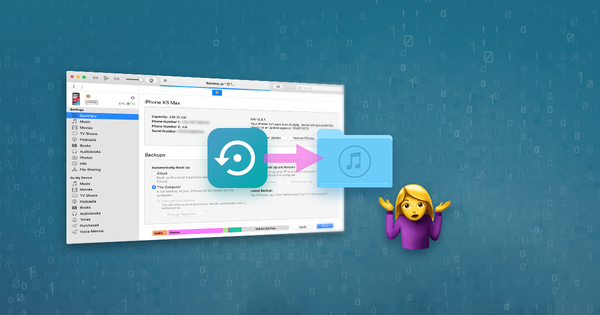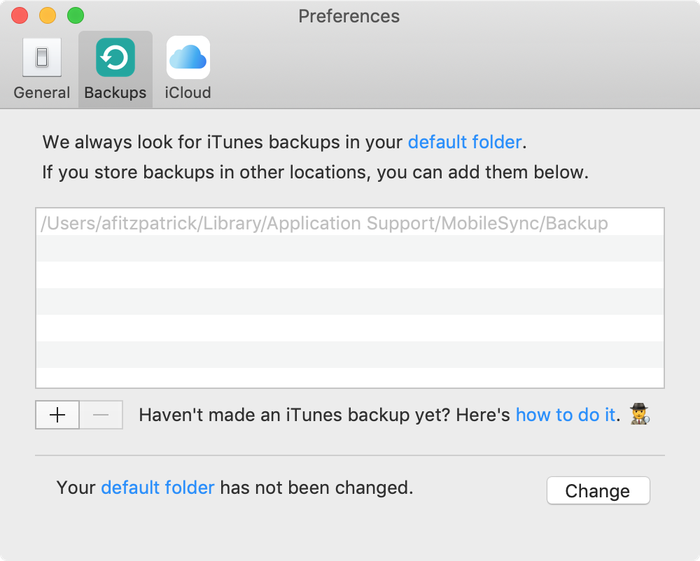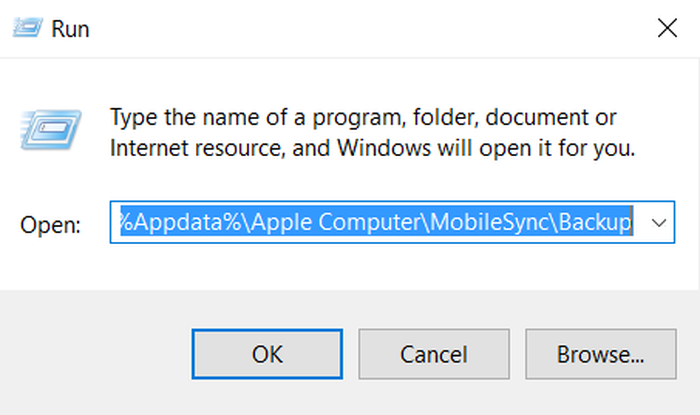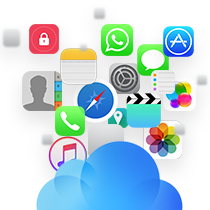Onde os backups de iPad e iPhone são armazenados no PC ou Mac?

Se você acidentalmente excluiu algumas informações de um dispositivo iOS e espera recuperá-las, um backup do iTunes pode ser uma grande ajuda.
Os backups do iTunes acontecem automaticamente, cada vez que você conecta seu iPad ou iPhone ao iTunes (se você não ativar a opção Backup do iCloud), ou manualmente, quando clica com o botão direito no dispositivo no iTunes e escolhe "Backup". Eles são salvos no seu computador e contêm dados importantes, como contatos, mensagens de texto, calendário, notas, histórico de chamadas e dados do aplicativo.
Então, onde estão armazenadas as cópias de segurança do iPhone ou iPad? Depende de qual sistema operacional seu computador está usando, embora o local de backup padrão seja o mesmo entre as versões do iOS.
Onde está a pasta de backup do iTunes no Windows?
Os backups do iTunes são armazenados em %APPDATA%\Apple Computer\MobileSync no Windows.
No Windows 10, 8, 7 ou Vista, esse será um caminho como \Users\[USERNAME]\AppData\Roaming\Apple Computer\MobileSync\Backup .
Com o Windows XP, seria semelhante a \Documents and Settings\[USERNAME]\Application Data\Apple Computer\MobileSync\Backup .
A versão do iTunes da Microsoft Store é um pouco diferente: ela armazena seus backups em %HOMEPATH%\Apple\MobileSync . Esse será um caminho como \Users\[USERNAME]\Apple\MobileSync\Backup .
Onde está a pasta de backup do iTunes no macOS / OS X?
Os backups do iTunes são armazenados em ~/Library/Application Support/MobileSync no macOS.
Essa pasta normalmente está em /Users/[USERNAME]/Library/Application Support/MobileSync/Backup .
No macOS 10.15, o Finder cria backups do iPhone, em vez do iTunes. No entanto, esses backups são armazenados no mesmo local.
Como encontrar a pasta de backup do iTunes automaticamente
O iPhone Backup Extractor encontra automaticamente a pasta de backup do iTunes e pode abri-la com um clique. Essa funcionalidade está na versão gratuita, então isso não vai custar nada.
- Baixe e instale o iPhone Backup Extractor
- Abra a janela
Preferencesno menu suspenso do aplicativo - Selecione a guia
Backups. - Onde a janela diz "Sempre procuramos backups na pasta padrão", clique no link "pasta padrão". Fácil!

Abrindo a pasta de backup do iTunes no Windows
Abra o local padrão do Backup no Explorer usando o comando Executar do Windows. Pressione ⊞ Win + R e a janela Executar deve aparecer. Digite %APPDATA%\Apple Computer\MobileSync e pressione ⏎ Enter .
Para a versão do iTunes da Microsoft Store, você pode fazer isso: Pressione ⊞ Win + R e a janela Executar deve aparecer. Digite %HOMEPATH%\Apple\MobileSync e pressione ⏎ Enter .
Aqui está o que isso parece no Windows 10:

A janela do Explorer que se abre mostrará uma pasta chamada "Backup". Contém todos os backups do iTunes que já estão presentes no computador.
Encontrando a pasta de backup do iTunes no macOS
O local de backup padrão pode ser mostrado no Finder usando o Spotlight. Pressionando ⌘ Cmd + e digite ~/Library/Application Support/MobileSync antes de pressionar ⏎ Enter .
A janela do Finder que se abre mostrará uma pasta chamada "Backup". Contém todos os backups do iTunes que já estão presentes no computador.
Alterar o local da pasta de backup do iTunes?
Se você quiser alterar a pasta de backup do iTunes por padrão, temos um guia prático em nosso centro de suporte.


de Sohaib Ahmed
Thanks alot.
Cheers.. .. .!!!
de Jake Lown
Hi, I would like to restore a previous backup but I'm having trouble finding out my backup password. Can you please help me with this?
responder por: Reincubate Support
Hey Jake, we've got a guide on password recovery. You can find it here.
de Gerry Wood
Many thanks for enabling me to find the backup file for my iphone on my PC. When I click on the properties of the backup file it shows that I have 2.23gb backed up in 3503 files which is reassuring.
If I now wish to view the contacts that have been backed up or restore them to a different device how do I do that if I've replaced my iphone with an android phone?
responder por: Reincubate Support
Hi Gerry, thanks for asking. We're glad the article was helpful. If you install iPhone Backup Extractor, you'll see the free edition lets you browse through all of your contacts. Try that — it can export your contacts into a
VCFformat that your Android will easily be able to import.de Apple Repair New Orleans
I plan to buy an iPhone 6S Plus from a client, but they want me to transfer all their data to their old 5C. I backed it up in iTunes, then plugged in the 5C, but the 6s backup is nowhere to be seen from the drop down list!
The 5C is 32GB and the 6S Plus is only 16GB, so I don't know what the problem is. Any ideas?
responder por: Reincubate Support
Hi guys, thanks for commenting. This one's an old chestnut: it's caused by one of the phones running a different version of iOS to the backup. Upgrade one or other so that they're running the same version, then update the backup. That'll sort it out!
de Justin
First of all; Thanks for the easy and helpful steps to get this far in the process. I am just curious as I am copying my backup off of my pc if it just as simple as me copying this backup off of my (non internet accessible) pc onto a hard drive, then I can drag and drop into the list of backups on the new Mac. I am trying to restore my old backup onto my new iPhone six, but my pc has lost ability to connect to the Internet, so I can't download the new iTunes update to be able to work with my iPhone six.
responder por: Reincubate Support
Justin! Thanks for writing. Yes, it really is that easy. You can move iTunes backup folders between Macs, or even between Macs and PCs.
de Brian Corbett
You have confirmed to me the preposterous nature of the iPad backup system. Why can't they use files like windows?
responder por: Reincubate Support
Hi Brian, the iOS device does all the work when making a backup and simply relays the data to the PC or Mac (or to iCloud). They use this format partly to make it straightforward (and fast!) for the device, but also to discourage inadvertent modification of files, and to easily be able to layer encryption on top. It works pretty well in most cases!
de Chris
i found the backup files but they look coded in jibberish. how can i read them as they would appear from my phone, opposed to being random numbers and letters? please halp
responder por: Reincubate Support
Hi Chris, that's what iPhone Backup Extractor does. Load up the free version, and choose "Expert mode". That'll show you the structure the files decode to. 👍
de Bennie
My iphone and ipad was backed on the same computer, will it be a separate folder or combine on the same folder?
responder por: Reincubate Support
Hi Bennie, they'll be in separate folders, both in the master
Backupsfolder. Each folder will be named after the phone's UDID, which is a long phrase name of letters and numbers.de Mosin
How do i get the contacts from the folder on to a android? could you please let me know as soon as possible please
responder por: Reincubate Support
Hi Mosin, thanks for commenting! We've got a guide that takes you through transferring contacts to Android here.
de sf
would u also tell me how do i get there..
i mean where i can find Users\USERNAME\AppData\Roaming\Apple Computer\MobileSync\Backup
as i am using windows 7
responder por: Reincubate Support
Hi sf: sure! We've updated the article to make it clearer that Windows backups are stored under a different location. Does that help?